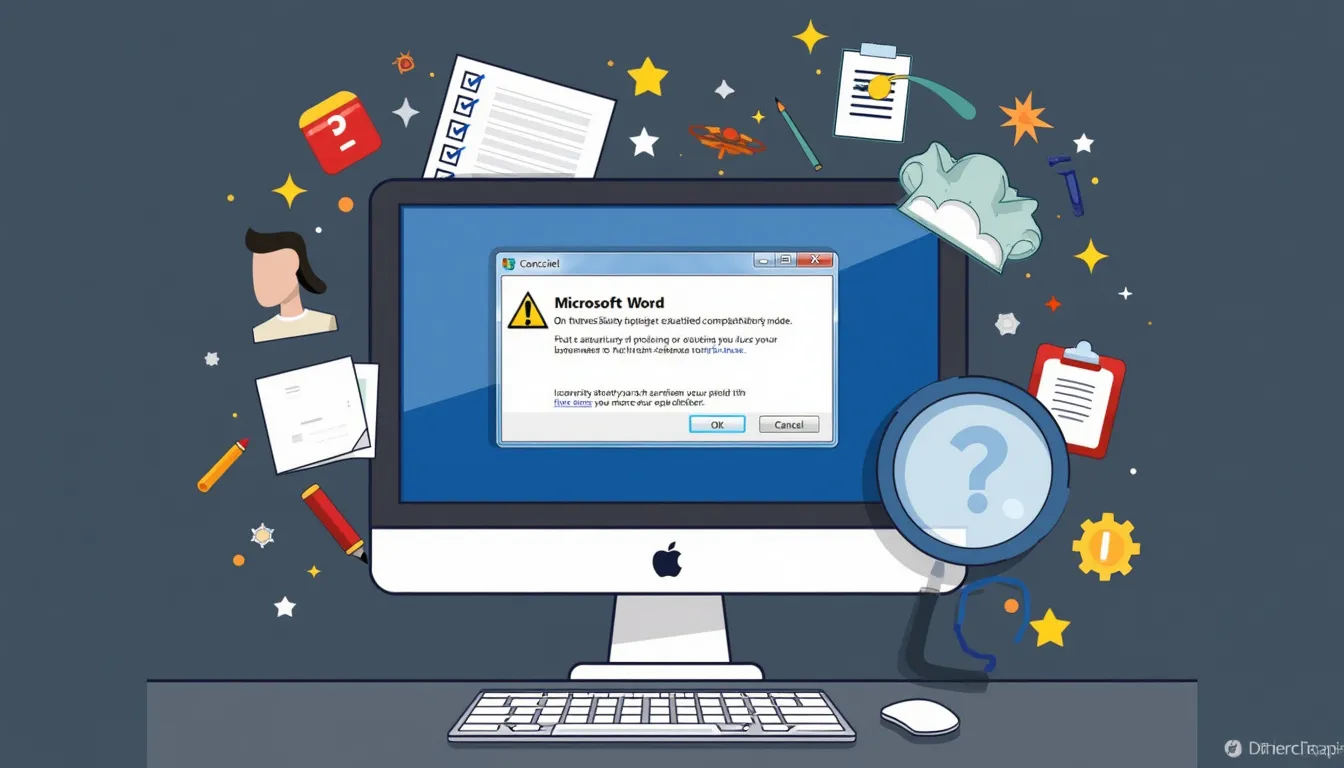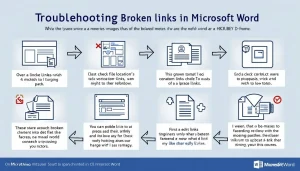Last Updated: September 15, 2024
Are you tired of wrestling with Microsoft Word Compatibility Mode issues? You’re not alone! It can be as frustrating as trying to figure out a Rubik’s Cube blindfolded. This article has come to your rescue! We’ll walk you through the ins and outs of troubleshooting Microsoft Word compatibility mode to help you regain control over your documents.
First, we’ll explain what Compatibility Mode is, why it exists, and the common problems you might encounter—like pesky file format limitations and missing functionalities. Then, we’ll arm you with effective strategies and easy steps to diagnose and resolve these issues. You’ll see how simple adjustments and file conversions can bring harmony back to your Microsoft Word experience.
So, if you’ve ever found yourself scratching your head at Compatibility Mode, buckle up! Let’s dive in and unleash the full potential of your Word documents. Whether you’re a casual user or a seasoned pro, you’ll find the guidance you need right here.
Table Of Contents
Understanding Microsoft Word Compatibility Mode
A. Definition and Purpose of Compatibility Mode
To make our lives easier (and less frustrating), Microsoft Word has a nifty little feature known as Compatibility Mode. But what exactly is it? In simplest terms, Compatibility Mode allows you to open and edit older Word documents without any worries about features that may not translate perfectly into the latest version of Word. Think of it as a bridge, ensuring your older files play nicely with the new-age software.
1. Explanation of Compatibility Mode in Microsoft Word
When you encounter an older document—say, a Word 97-2003 file—and attempt to open it in a newer version of Word, the software seamlessly activates Compatibility Mode. This protective layer preserves the original formatting and functionality so that you don’t unintentionally alter the document while editing. It’s like putting your old text inside a time capsule!
2. Reasons for using Compatibility Mode
- Preserving Formatting: This helps keep your document’s original fonts, layouts, and features intact.
- Interoperability: Allows for sharing documents with users still on older versions of Word.
- Ease of Use: Reduces the risk of encountering errors arising from mismatched versions.
B. Common Compatibility Mode Issues
While Compatibility Mode can be a lifesaver, it’s not without its quirks. Some common issues can throw a wrench in your smooth editing process, causing you to troubleshoot Microsoft Word compatibility mode more often than you’d like!
1. File format limitations
Every time you encounter Compatibility Mode, you want to jump for joy — until you realize that there are limits! Here are a few things to keep in mind:
- Older file formats, like SmartArt or certain charts, might not support new features.
- Changes made in Compatibility Mode may not save correctly in the old format.
- You might not be able to access or edit specific functions like text effects or other recently introduced features.
2. Feature restrictions and missing functionalities
Working in Compatibility Mode might sometimes feel like navigating a minefield; you might step on an unseen feature and—boom!—you lose access to functionalities that could have made your document shine. Common feature restrictions you might encounter include:
- Inability to use modern fonts
- Restrictions on certain table styles and designs
- Absence of certain graphics capabilities (like 3D models)
Tips for Identifying Compatibility Mode Issues
Now that we understand the purpose and common issues associated with Compatibility Mode, let’s focus on how to identify those pesky problems for easy troubleshooting!
1. Identifying the file version and format
Start by checking the file version. In Word, go to File > Info — this will show you whether the file is in Compatibility Mode. If you’re unsure about the format, pay attention to the file extension:
| File Extension | Word Version |
|---|---|
| .doc | Word 97-2003 |
| .docx | Word 2007 and later |
| .dotx | Word 2007 and later (template) |
2. Checking compatibility settings and options
Head over to the Options menu to investigate potential mismatches:
- Go to File > Options > Save and check ‘When saving this document’ – you can adjust how Word handles older formats here.
- Under File > Options > Advanced, look for document-specific settings and features that may not be available in Compatibility Mode.
By keeping these tips in mind and actively checking for common issues, you’ll be better equipped to troubleshoot Microsoft Word compatibility mode more effectively. So, whether you’re dealing with stubborn formatting issues, legendary layout remains, or just missing features, knowing what to look for can save you time, energy, and maybe even a few drags through the document desert!
And remember, when all else fails, community support and resources are always available from trusted platforms like Microsoft Support or forums where fellow users share solutions.
Stay tuned for the next section, where we dive deeper into strategies for resolving Compatibility Mode issues. Happy editing!

Effective Strategies to Troubleshoot Microsoft Word Compatibility Mode
A. Steps to Diagnose Compatibility Mode Problems
1. Identifying the File Version and Format
To successfully troubleshoot Microsoft Word compatibility mode, start by understanding your file. Here’s how to identify the version and format:
- Open the document in Microsoft Word.
- Click on File > Info.
- Look for the Properties section. You should see the file type listed, such as .docx or .doc.
This is crucial because older formats like .doc may keep you in compatibility mode, limiting features. Remember, .docx is the newer format that offers many more features and supports better collaboration.
2. Checking Compatibility Settings and Options
After identifying the file version, the next step is to check compatibility settings.
Follow these steps:
- Click on File > Options.
- Under Advanced, scroll down to Compatibility options for and select your document’s name.
- Review the list of features that may be disabled due to compatibility settings.
Being aware of these settings enables you to tailor your experience and utilize Word to its full potential!

B. Solutions for Resolving Compatibility Mode Issues
1. Converting Files to the Latest Word Format
One fantastic solution to troubleshoot Microsoft Word compatibility mode is converting your document format. Here’s how to do it:
- Open your document.
- Click on File > Save As.
- Select a location to save.
- In the Save as type dropdown menu, choose Word Document (*.docx).
- Click Save.
Converting to the latest format not only removes compatibility mode but also unlocks the newest features Microsoft Word has to offer.
2. Adjusting Settings and Preferences for Optimal Performance
Sunshine and roses! It’s time to shine a light on your settings:
Follow these steps to adjust settings:
- Open Microsoft Word and go to File > Options.
- Select Trust Center > Trust Center Settings.
- Review settings under Protected View, as this can inhibit full functionality.
- Also, check File Locations for auto-recovery options.
Adjusting these settings can enhance your Word experience and keep you on the road to productivity!

3. Seeking Additional Resources and Support for Persistent Issues
If you’ve tried everything and you still can’t seem to troubleshoot Microsoft Word compatibility mode, don’t hesitate to seek additional resources:
– Microsoft Support: The official Microsoft Support page can provide in-depth guides and instructions. Microsoft Word Help & Learning.
– Community Forums: Websites like Tech Community allow you to connect with experts and other users who may have faced similar challenges.
– YouTube Tutorials: There are numerous visual guides available that help troubleshoot what you can’t figure out verbally. Just search for “troubleshooting Microsoft Word compatibility mode” and find a slew of tutorial videos!
Utilizing these resources enhances your ability to resolve compatibility issues and empowers you to make full use of Microsoft Word.
By following these strategies, you’ll be well-equipped to troubleshoot Microsoft Word compatibility mode. Say goodbye to frustration and hello to seamless document editing!
Conclusion
Troubleshooting Microsoft Word compatibility mode doesn’t have to be a daunting task. By understanding what compatibility mode is and why it can be both a blessing and a curse, you’ve equipped yourself with the knowledge to navigate common issues. Remember, the key to tackling these problems lies in diagnosing them effectively and employing solid solutions, whether that means converting files, adjusting compatibility settings, or reaching out for help when necessary.
With a clear plan in mind, you can efficiently address any compatibility hiccups, allowing you to focus on what truly matters: creating stunning documents that shine. As you move forward, keep these strategies in your toolkit, and you’ll be ready to troubleshoot Microsoft Word compatibility mode like a pro!





